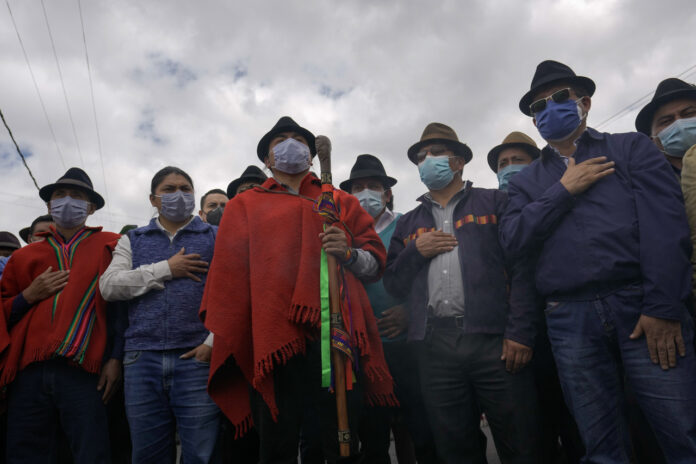After the election of Guillermo Lasso, an ultra-conservative banker, in fact, a full member of the Opus Dei sect, as President of the Republic in 2021, a sui generis political situation arose in Ecuador. Lasso had to coexist with a Parliament that was dominated, in two thirds, by forces of the left and the centre left.
Despite this, as soon as he took office as President of the Republic, Lasso put his foot on the accelerator of neoliberal reforms. In the first few months, he had aggressively advanced his programme of privatisation almost without any opposition; in fact, he dismantled the main state insurance company, Seguros Sucre, to spread out the insurance market, especially public infrastructure, among his financial partners.
He also created a market for the commercialisation of hydrocarbons, mainly supported by the state company Petroecuador, through the increase in fuel prices in such a way that it would become a profitable market for private investors. Fuel importers could use the state infrastructure without paying a penny for it. He issued several regulations to create a market for the distribution of electricity, in which he transferred regulatory capacities to private companies.
From the Presidency, he was also able to block the attempt by various sectors who wanted financial relief through further regulations in banking, in an economy that was still in shock from the Covid-19 pandemic. At the end of 2021, his bank, Banco de Guayaquil, would have its best profits in the last two decades. In a medium-term horizon, Guillermo Lasso has proposed the privatisation of the second largest bank in the country, Banco del Pacífico, which has belonged to the State since the bank crisis of 1998-1999. If successful, he would go on to dispute the first place in banking with his most important competitor, banker Fidel Egas of the Banco del Pichincha economic group.
Still, Lasso needed to broaden the horizon of privatisations, deregulation, the opening of the economy and labour flexibility. In the last quarter of 2021, he sent a bill to the National Assembly with more than 400 articles to reform more than thirty laws. The most contentious of the reforms proposed by the government were the labour reforms.
In these, President Lasso stated that when workers were dismissed without notice, they were the ones who had to compensate the employer who fired them. In the same law, child and adolescent labour was reintroduced despite the fact that Ecuador has signed international human rights instruments that prohibit child labour. The National Assembly, pressured by society, refused to approve a reform that would have taken the country back to the 19th century.
“The Pachakutik movement […] was never able to become the true balance and, in order not to fall on the side of Correism, it fell on the side of the government”
In this context, the indigenous movement was able to block, timidly, the incessant increase in fuel prices and managed to extract a commitment to freeze the prices of diesel and liquefied petroleum gas.
Now, what is striking is that Guillermo Lasso’s neoliberal reforms were processed independently and on a different track from the political system and political debate. The political parties and movements could not do much to avoid it, except to oppose extremely radical laws.
In the first year of government, the political debate continued between the supporters of former President Rafael Correa, who wanted to become the only opposition, and Guillermo Lasso’s right. In this game of mirrors, the political representation of the indigenous movement, the Pachakutik movement, despite having captured the presidency of the National Assembly, was never able to balance the act and, in order not to fall on the side of correismo, it fell on the side of the government.
At the end of 2021, the government again sent a package of neoliberal reforms that included the privatisation of the public development bank, new taxes for the middle classes through changes in the calculation of income tax, a new regulatory framework for oil contracts, among other reforms.
What is paradoxical and contradictory is that these neoliberal reforms were finally approved by the National Assembly thanks to the last-minute support that the government of Guillermo Lasso had from their apparently staunch opponents, the political movement of former President Rafael Correa, called UNES (Union for the Hope). However, what almost abruptly ended the government of Guillermo Lasso were the denunciations of the Pandora Papers of the International Consortium of Investigative Journalism. There it was shown, in an absolutely clear way, that Guillermo Lasso should have been unable to even register as a candidate for the Presidency given his properties in trusts and tax havens, which the law prohibited. Curiously, he was able to save himself thanks to the support, this time, of the Pachakutik movement.
Meanwhile, the country was collapsing. Unemployment and underemployment rose dramatically. Of every ten people able to work, only three of them had a job. Poverty, which in 2017 stood at 23%, was estimated for 2022 at 32%. Public investment in health, education, social inclusion fell to its worst indicators for decades. To give you an idea, the government of Guillermo Lasso had reduced public investment to 1.8 billion dollars by 2022 (the average was 4 billion USD); however, in the first quarter of that year it had barely invested 67 million USD (0.37% of what was planned).
Curiously, the economy was experiencing a boom: remittances from migrants reached 4% of GDP for the first time, the price of oil had almost doubled in relation to what was calculated for the budget proforma, tax collections had risen significantly. The government was able, just in the first three months of 2022, to eliminate the fiscal deficit calculated at 2.5% of GDP. Poverty, social deterioration, were not due to any crisis, but to deliberate government policies in collusion with the IMF.
“In his first year in office, Guillermo Lasso led his society into the abyss. He led to propose free trade agreements with economies that compete directly with the little that is produced in the country”
The situation in the public sector was increasingly dramatic. A procedure as simple as renewing one’s identity document or obtaining a passport, which in general terms took a few minutes, took months because there were no resources or staff to do it. The budget for the prison system was reduced by 80%. The conflict in prisons spilled over into society and became a public health problem due to the number of murders by hit men.
In his first year in office, Guillermo Lasso led his society to the abyss. He proposed free trade agreements with countries that compete directly with the little that the Ecuadorian countryside produces and increasingly insisted on more aggressive neoliberal reforms than all those that had been approved until then. The popularity and credibility of President Lasso, which in the early days exceeded 70% due to his successful management of the Covid-19 vaccines, decreased to less than 30% in his first year.
It is in this context that the indigenous movement has insisted on the commitments that President Lasso made in his first days in office, to stop the increase in fuel prices and support the small peasant economy.
Despite their many insistences, President Lasso always put off CONAIE (Confederation of Indigenous Nationalities of Ecuador, the main national indigenous organisation), and thought that with his agreements with the Pachakutik movement (which is CONAIE’s political party), he had more than enough to control the indigenous movement.
The new leadership of CONAIE, led this time by the indigenous leader of Cotopaxi, Leonidas Iza Salazar, adopted, before Guillermo Lasso, a more radical tone than the one that the members of the Pachakutik in parliament had had with respect to the government up to that moment.
“Iza realised that the unity and rescue of the indigenous movement could not be circumscribed or limited within the narrow confines of the political system and decided to appeal to his own organisation”
During his first months as president of CONAIE, Leonidas Iza devoted himself to traversing the country, visiting each of the local indigenous organisations and putting his finger on the pulse of the indigenous movement and society. He understood that the country was in a state of turmoil. When he asked his own assembly members to be more radical with respect to the neoliberal Lasso government, he was able to confirm that the majority of his parliamentary block (Pachakutik has 18% of all parliamentary representation) decided to support the Lasso government rather than its own parent organisation (CONAIE).
Then Leonidas Iza understood that the unity and rescue of the indigenous movement could not be circumscribed or limited within the narrow confines of the political system and decided to appeal to his own organisations. He held assemblies in all the regions and in as many communities of his organization as there were, and there he ignited the spark of a national mobilization.
After almost a year of listening to the voice of his people, in a Congress of his organisation, CONAIE, it was decided to go to a national mobilisation on June 13, 2022 with ten points: (1) freezing of the prices of fuels; (2) economic relief for small debtors in the banking and financial system overwhelmed by debts and coercion; (3) fair prices for farm products (milk, rice, bananas, potatoes, etc.); (4) employment policies and labour rights; (5) moratorium on the extractive frontier; (6) respect for the collective rights enshrined in the Constitution; (7) stopping the privatisation of strategic sectors and, especially, of public development banks; (8) price control policies for essential goods; (9) budget for health and education and free admission of young people to the university system; and, (10) effective public policies against crime, hit men and violence.
As can be seen, the CONAIE platform, built from consensus, dialogue and communality, popular and social participation, proposes a minimum of public policies that can be signed by any government with a minimum of good sense. It is a plausible, coherent platform that was due to the moment and the circumstances. It did not raise any extremism or ideological questions about economic policy (such as suspending agreements with the IMF).
Leonidas Iza knew that a platform like this had to be built gradually and that there had to be strong social pressure on the government to change the aggressive neoliberal policy as a highly ideological, extremely conservative and racist government.
Therefore, CONAIE was prudent and proposed a national, territorial and indefinite mobilisation. National because it encompassed the entire country and opened the umbrella so that new social actors could be incorporated, step by step, as the social struggle progressed; territorial because the mobilisation began in the indigenous territories, it was maintained and consolidated in them (that is, marches to the capital were not planned as in an uprising); and indefinite because it was a long-term struggle.
A neoliberal regime as fundamentalist as that of Guillermo Lasso will not change its ideological core even if the circumstances become intolerable. That is why CONAIE’s strategy was to situate the political struggle in the long term, appeal to the organisations and recover its legislative bloc, while changing the centre of the political discourse to remove it from the binarism (false by the way) between correismo and anticorreismo.
It was an appeal to the same strategy of 1990, when the first indigenous uprising took place since the return to democracy. It was a prudent position that started from the recognition of their own strengths but also of their weaknesses. If the mobilisation was sustained in the territories, then it could last a long time and the government, given that extension, would sooner or later have to give in.
“For the regime, the CONAIE mobilisations had to be prevented at all costs from turning into another October 19. If that were to happen, the government would not be able to resist such a strong mobilisation”
However, for the bourgeoisie and for the government, there was a ghost that had to be exorcised, it was the mobilisations of October 2019, the strongest mobilisations in the entire recent history of the country. Now, a CONAIE mobilisation, of any magnitude, appealed to those ghosts that had to be exorcised. Therefore, the government’s strategy was to use Pachakutik to divide and wear down the indigenous movement. In fact, it had important allies within the Pachakutik movement for the success of that strategy.
Leonidas Iza changed the game board and forced the government to change its strategy, but the problem is that Lasso and his cohorts did not have a plan B in the face of that change of strategy. As if it were a classic battle, the government thought that if it decapitated the indigenous movement and left it without its referent and most important leader, Leonidas Iza Salazar, then, and without its most valuable general, the indigenous movement could implode and the mobilisations would soon die.
For the regime, it was necessary to avoid at all costs that the CONAIE mobilisations became another October-19. If that happened, the government could not resist such a forceful mobilisation, its political capital was too small for that.
Driven by the fear of its own demons, the government of Guillermo Lasso made its most strategic and fatal mistake, deciding in the early hours of June 14, 2022, just one day after the CONAIE mobilisations began, to arrest Leonidas Iza Salazar in the province of Cotopaxi.
But they stop him without any type of legal argument, because Leonidas Iza was protected by article 98 of the Constitution, which protects the right to resistance. Having no legal arguments to legitimise that detention and given the position of the State Attorney General’s Office to refrain from accusing Leonidas Iza, the arrest of the indigenous leader became a kidnapping, that is, a State crime.
But kidnapping is too strong a legal figure because it can lead directly to impeachment of the President of the Republic (number 3 of article 129 of the Constitution establishes that the President can be subjected to impeachment: “for crimes of genocide, torture, forced disappearance of persons, kidnapping or homicide for political or conscientious reasons”).
As soon as the news of the arrest of the maximum leader of the indigenous movement Leonidas Iza Salazar were known, the indigenous communities decided to radicalize their positions and what was only a territorial and indefinite mobilisation suddenly became an indigenous uprising.
The same night that he was arrested in the province of Cotopaxi, the community members and leaders of the CONAIE branches decided to move on to a new stage of struggle and a new slogan: the capture of Quito to free their leader. In a few hours, the meaning and strategy of the mobilisation changed.
The arrest of the indigenous leader calls for the solidarity of Tyrians and Trojans and the government is practically left alone, only with the support of the most conservative and reactionary sectors of society. The government knows that the rigorous formalities established in the Constitution and the law have not been complied with and decides to improvise. In that improvisation they decide to kidnap the president of CONAIE in a military base until the situation resolves itself.
The outrage was growing and motivated other social sectors to claim for the freedom of the indigenous leader and join the mobilisation that, this time, is already an uprising. Teachers, workers, environmentalists, feminists, intellectuals, university professors, among others, begin to join the uprising. At dawn on June 15, the indigenous community members arrive in Quito and the occupation of Quito begins. 32 years after the indigenous uprising of 1990, an indigenous uprising is taking place again in the midst of Inti Raymi, the festival of the sun.
“CONAIE once again takes the political debate out of its liberal corset and places it back in its natural space, that of the class struggle”
Given these circumstances, the leadership of the Pachakutik movement, which had divided into a faction in favour of President Lasso and another in favour of the President of CONAIE, Leonidas Iza, decided to meet again and form a single front in parliament and stand in solidarity with their main political leader.
But there is another fact that needs to be pointed out, and that is that CONAIE once again takes the political debate out of the liberal corset and places it back in its natural space, that of the class struggle. It forces a position to be taken and establishes a dividing line with the neoliberal strategy of the Lasso government and, in this way, allows politics to breathe outside the false dichotomy between correistas and anti-correistas.
In less than a day, and thanks to the gross errors of President Lasso, who, from what can be seen, does not have the remotest idea of how the indigenous movement works, radically changes the situation and subjects President Lasso to a situation of extreme weakness.
Translation: Gabriel Vera Lopes (ALAI)








